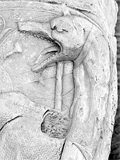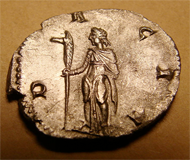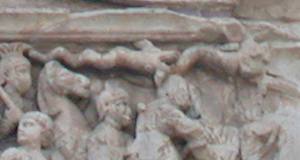
This page created 28 August 2014, and last modified: 3 December 2015 (Maier reference numbers added)

The Equites citrati iuniores is listed (102/5.37 in Ingo Maier's numbering scheme) as the 25th of the vexillationes comitatenses in the Magister Equitum's cavalry roster; it is assigned (102/5.244) to the Comes Africae as the Equites crinati iuniores. Its shield pattern (101#15), as shown in various manuscripts under the label (101.p) Citrati iuniores, is as below:

Note that Seeck amended (OC.VI.74) the unit's name to the Equites cetrati iuniores, with an "e" (and indeed, it is so-spelled in the illustrations accompanying the printed Froben edition; either implying a superior textual transmission via the lost Basel manuscript, or editing by Rhenanus).
The shield pattern has a blue boss quartered with white (W), with blue (O, P), or unquartered (M); B instead has white quartered with white. The main field is green (faded to yellow in M); it is charged with a blue disc (yellow in M, white in B) at the 9 o'clock position (3 o'cock in B, which, being printed, reverses all the shield facings), and also a large yellow draco - a military standard that was introduced to the Roman forces during the 2nd century AD as a result of the Dacian wars, and which became more popular with time, to judge from e.g. Vegetius, in which a cohort is given its own standard, kept by a draconarius. Despite the name "draco" (serpent, dragon), illustrations of dracones often seem to feature a head that looks more wolf-like than serpent-like.

|

|

|
|
|
|
|
|
|
|
|
The disc, despite appearing plain, is probably intended to represent an imago - an imperial portrait. This can be seen by comparing some other shield patterns of draco-bearing units, using the patterns taken from the Paris manuscript:

The "unlabelled" pattern (106#5) from the western Magister Officiorum is actually drawn much larger than the other two in the mansucripts, allowing the imperial portrait to be clearly depicted.
The name cetrati refers to a small shield, a "cetra", and more classically a "caetra", and which was typical of Spanish light infantry in the Roman republican era. The word was used by Latin-writing authors to cover a multitude of shields smaller than a typical large Roman "scutum", and while thus typically used for shields borne by light infantry, it also encompassed the heavy bronze-faced shields carried by Macedonian phalangites, which were however, "just" 60 to 75 cm in diameter. It is possible the men of the Equites c[e]trati iuniores carried smaller shields than standard cavalrymen, but it is also possible that the name was anachronistic in much the same way that scutarii had become: scutarii had come to have a secondary meaning of "guardsmen" by this date, and not just "scutum-bearers".
1. Ingo Maier; "Appendix 4: Numeration of the new edition of the compilation 'notitia dignitatum' (Cnd)"; last accessed 26 October 2015. See also for here for numbering examples. Return
2. Otto Seeck (Ed.); "Notitia Dignitatum accedunt Notitia urbis Constantinopolitanae et Latercula prouinciarum", Weidmann, Berlin, 1876; available here (last accessed 26 October 2015). Return
3. Publius Flavius Renatus Vegetius ("Vegetius"); "Epitoma rei militaris", 2.13; available here in Latin and here in English (last accessed 3 December 2015). Return

Return to the Notitia alphabetical unit list page.
Return to my Notitia index page.